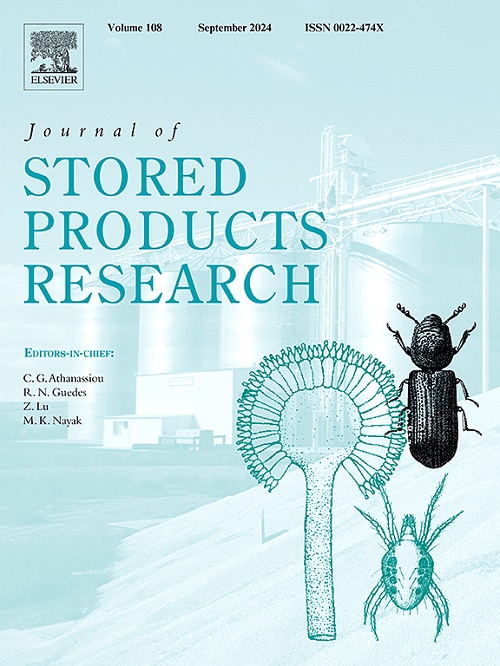Management strategy evaluation of stored grain using global sensitivity analysis: Part I – Allowable maximum variations of temperatures and moisture contents of canola
IF 2.7
2区 农林科学
Q1 ENTOMOLOGY
引用次数: 0
Abstract
To maintaining grain quality and quantity, stored grain should be stored at low temperatures and dry moisture contents with minimum variations of temperature and moisture content. Global sensitivity analysis was conducted to characterize these allowable variations by simulating different ranges of temperature, moisture content, and initial germination with different distributions of the simulated temperatures, moisture contents, and initial germinations. Mathematical models published in literature for predicting canola germination were coded in Symbiology and Simulink for conducting these simulations. Random and normal distributions of temperatures, moisture contents, and initial germinations were simulated. Simulations covered ranges of temperature (5–40 °C), moisture (6–12 %, wet basis), and initial germination (92–98 %) variations to assess their effects on germination reduction. Simulation results and global sensitivity analysis concluded that the allowable maximum variations of moisture content in stored canola granaries depended on the variation of temperatures, and vice versa. Any moisture variation would reduce the recommended safe storage time. The allowed maximum standard error of moisture contents for one third of the recommended safe storage time was 0.5, 0.5, and 0.1 percentage point at 18 ± 3, 23 ± 3, and 28 ± 3 °C, respectively. These findings provide critical guidelines for optimizing canola storage conditions to minimize spoilage risk.

使用全局敏感性分析的储藏谷物的管理策略评价:第1部分-油菜籽温度和水分含量的允许最大变化
为保持粮食的品质和数量,储粮应在低温、干燥、温度和水分变化最小的条件下贮藏。通过模拟不同温度、水分含量和初始发芽率的不同分布,进行全局敏感性分析来表征这些允许变化。在Symbiology和Simulink中编写了预测油菜发芽的数学模型来进行这些模拟。模拟温度、水分含量和初始发芽的随机分布和正态分布。模拟包括温度(5-40°C),湿度(6 - 12%,湿基)和初始发芽(92 - 98%)变化范围,以评估它们对发芽减少的影响。模拟结果和全局敏感性分析表明,油菜籽仓含水量允许最大变化取决于温度的变化,反之亦然。任何水分变化都会缩短建议的安全储存时间。在推荐的安全储存时间的三分之一内,水分含量允许的最大标准误差分别为0.5、0.5和0.1个百分点,温度分别为18±3、23±3和28±3℃。这些发现为优化油菜籽储存条件以减少腐败风险提供了重要指导。
本文章由计算机程序翻译,如有差异,请以英文原文为准。
求助全文
约1分钟内获得全文
求助全文
来源期刊
CiteScore
5.70
自引率
18.50%
发文量
112
审稿时长
45 days
期刊介绍:
The Journal of Stored Products Research provides an international medium for the publication of both reviews and original results from laboratory and field studies on the preservation and safety of stored products, notably food stocks, covering storage-related problems from the producer through the supply chain to the consumer. Stored products are characterised by having relatively low moisture content and include raw and semi-processed foods, animal feedstuffs, and a range of other durable items, including materials such as clothing or museum artefacts.

 求助内容:
求助内容: 应助结果提醒方式:
应助结果提醒方式:


